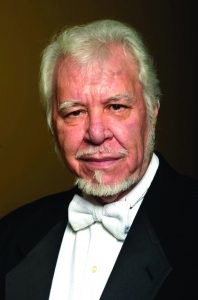The New Orleans Opera will stage Pygmalion, Jean-Phillippe Rameau’s 1748 one-act acte-de-ballet, at Le Petit Theatre du Vieux Carré from November 8 to 11 in tribute to NOMA’s presentation of The Orléans Collection. Opera Director Robert Lyall spoke about how this performance will incorporate art from the exhibition into set design.
How did you conceive of this partnership between NOMA and the New Orleans Opera?
I attended the initial press conference where all of New Orleans’ cultural institutions were presenting their Tricentennial projects. The one that intrigued me the most was the statement by NOMA that there would be an exhibition of part of the famous art collection of the Duc d’Orléans, one of the greatest collections of its time. I thought, How interesting, there is a musical equivalent to that, which would be some example from French Baroque opera … Perhaps there’s a way for us to combine both of our interests and further our respective missions, so I undertook an examination of the French Baroque repertoire.
The one thing that was in abundance at the court of Louis XIV was money, and the other was a splendor in the arts that has garnered a lot of historical attention and praise. It led to the creation of French opera, and the court dances became a central part of that style, furthered by the fact that Louis XIV loved to dance. He loved to have theater pieces done at his court, and he himself would rise from the throne and join the dance scenes. I thought, What can we do that is not so lavish that it breaks the bank but can capture the spirit of what French opera focused on at that time? Pygmalion was the perfect fit.
What is the history of Pygmalion as an opera?
The subject matter of almost all early opera, whether the Italian origins of it with the Florentine Camerata, or, in the case of French opera, the court, was Greek and Roman mythology. Pygmalion was the son of the King of Crete and was famous as a sculptor. The myth is that he created the perfect female statue that was so beautiful he fell in love with his own work. Then he implored the goddess Venus, or L’Amour as she is called in most French works, to bring the statue to life so that his love would not be futile. Lo and behold she did! We’re staging Pygmalion at Le Petit Theatre in the French Quarter, a more intimate and historic venue that is closer to the era of New Orleans as America’s First City of Opera, at least according to documentation.
How will works from The Orléans Collection be incorporated into the production?
The setting of Pygmalion is an artist’s studio so I thought I could take projections of some of the paintings from the museum’s exhibition and make them a part of the scenic elements for our drama. I got in touch with Lisa Rotondo-McCord, director of the curatorial staff, and the idea was met with great enthusiasm. I soon realized that we might want to supplement those paintings, so she agreed that we could also use projections of appropriate works from NOMA’s permanent collection. This has enhanced the production and heightened the role that the museum is playing in creating this unique project. At about 45 minutes long, Pygmalion is not a full evening of opera. After a wonderful champagne intermission to celebrate the combination of our two art forms, we will offer a second half that I call a “divertissement.” It will consist of eight short and colorful selections from two generations of the leading composers of the French Baroque. The evening will conclude with the famous rondò from Rameau’s Les Indes Galantes, which actually takes place in New Orleans!
Tell us more about the preview production in the Besthoff Sculplture Garden.
On Sunday, October 14, we will perform little vignettes in the sculpture garden, the perfect setting to present the idea that a piece of art comes to life. The audience will be treated to a moveable feast, if you will, in that they will be guided from statue to statue that will come to life and sing. This event is free and open to the public.
• • • • • • •
Pygmalion will feature local talents Sarah Jane McMahon as L’Amour (Venus), Paul Grovves as Pygmalion, Rachel Looney as La statue animée, and Haley Whitney as Cephise. The Marigny Opera Ballet will serve as dancers, and a Baroque orchestra will be drawn from the Louisiana Philharmonic. NOMA members may receive a 10% discount on tickets by typing in the code NOMA10. For more information and to purchase tickets, visit neworleansopera.org.
